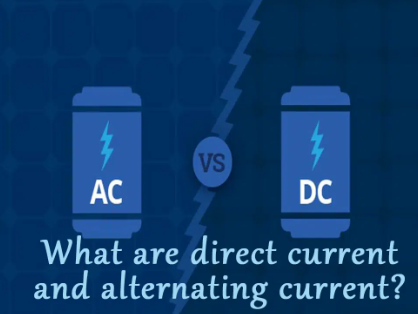What are direct current and alternating current?
What is direct current?
Direct current refers to a current whose magnitude and direction do not change within a certain time range. Many electrical appliances that do not contain inductive components are driven by direct current, such as radios, speakers, etc.

What is alternating current?
Alternating current refers to a current that continuously changes periodically in magnitude and direction. Usually alternating current changes according to the sine law or the cosine law. The current first changes from zero to the maximum, then from the maximum to zero, and then from zero in the opposite direction. It changes to the maximum, then changes from the maximum to zero, completing a cycle, and changes like this repeatedly.
Direct current VS alternating current – what are the differences?
Flow of Current:
Direct Current (DC): The current flows continuously in one direction. Electrons move in a single direction, like in a battery-powered circuit.
Alternating Current (AC): The current changes direction periodically at a certain frequency. Electrons oscillate back and forth in direction over time. Household electricity and power grids commonly use AC.
Generation:
Direct Current (DC): Typically generated by devices like batteries, solar panels, or DC generators.
Alternating Current (AC): Produced in power plants using generators and transformers to create alternating currents.
Applications:
Direct Current (DC): Used in battery-powered devices such as phones, computers, electric vehicles, and equipment requiring stable voltage.
Alternating Current (AC): Widely used in household electricity, industrial equipment, and power transmission systems due to its ability to easily adjust voltage using transformers, transmit power over long distances, and convert to different voltage levels conveniently.
The role of direct currentDirect current is widely used in various situations. The following are its main uses:
Test equipment for research units and laboratories and power supply for product aging life experiments.
Charging batteries.
Automotive applications.
Manufacturing testing.
Other low voltage, low current applications.
The function of alternating currentAlternating current is widely used in daily life and industry. Its main functions include:
Transmitting power over long distances: AC is more suitable for long-distance power transmission because its voltage and current are stable and there is less loss during transmission.
Powering household appliances: Almost all household appliances such as televisions, air conditioners, refrigerators, ovens, etc. use AC as the power source.
Driving electric motors: AC is widely used to drive various electric motors such as household washing machines, automobiles, fans, pumps, and high-speed trains.
Lighting: Modern lighting systems, such as LED lights and fluorescent lights, also use AC as a power source.
Provides stable power supply: The stability of AC power makes it ideal for industrial and commercial purposes, especially where precise control of power supply is required.
Flexibility: AC power can be controlled through a transformer or frequency converter, making household appliances and other equipment work more stably.
Applicability: In some specific scenarios, such as high altitude areas or ships, DC power cannot be used, and AC power becomes the only option.
Conclusion
In general, alternating current has great advantages in power supply, transmission and portability. These advantages make alternating current an indispensable form of energy in daily life and industrial production.
在线留言询价
- 一周热料
- 紧缺物料秒杀
| 型号 | 品牌 | 询价 |
|---|---|---|
| CDZVT2R20B | ROHM Semiconductor | |
| RB751G-40T2R | ROHM Semiconductor | |
| MC33074DR2G | onsemi | |
| BD71847AMWV-E2 | ROHM Semiconductor | |
| TL431ACLPR | Texas Instruments |
| 型号 | 品牌 | 抢购 |
|---|---|---|
| IPZ40N04S5L4R8ATMA1 | Infineon Technologies | |
| STM32F429IGT6 | STMicroelectronics | |
| TPS63050YFFR | Texas Instruments | |
| BP3621 | ROHM Semiconductor | |
| ESR03EZPJ151 | ROHM Semiconductor | |
| BU33JA2MNVX-CTL | ROHM Semiconductor |
- 周排行榜
- 月排行榜
AMEYA360公众号二维码
识别二维码,即可关注
























